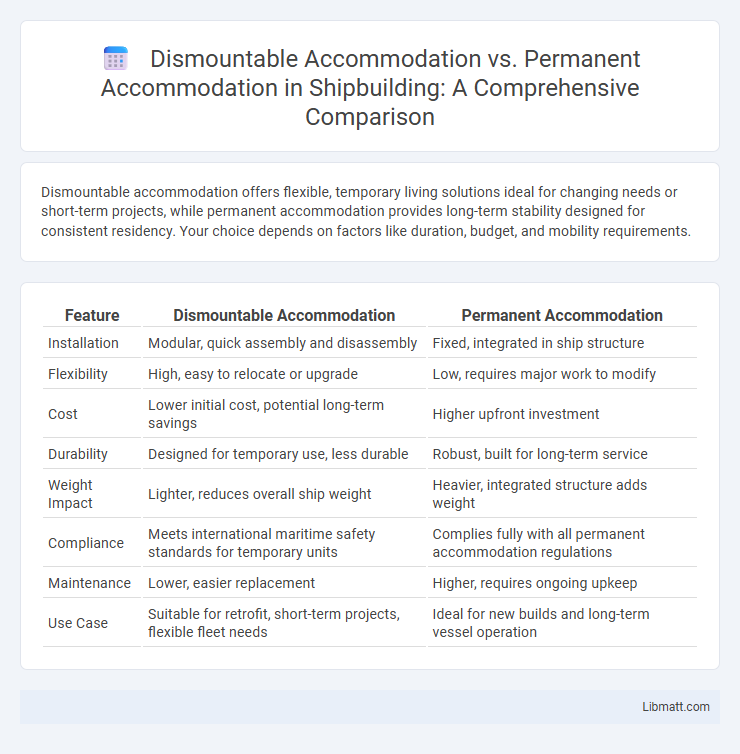Dismountable accommodation offers flexible, temporary living solutions ideal for changing needs or short-term projects, while permanent accommodation provides long-term stability designed for consistent residency. Your choice depends on factors like duration, budget, and mobility requirements.
Table of Comparison
| Feature | Dismountable Accommodation | Permanent Accommodation |
|---|---|---|
| Installation | Modular, quick assembly and disassembly | Fixed, integrated in ship structure |
| Flexibility | High, easy to relocate or upgrade | Low, requires major work to modify |
| Cost | Lower initial cost, potential long-term savings | Higher upfront investment |
| Durability | Designed for temporary use, less durable | Robust, built for long-term service |
| Weight Impact | Lighter, reduces overall ship weight | Heavier, integrated structure adds weight |
| Compliance | Meets international maritime safety standards for temporary units | Complies fully with all permanent accommodation regulations |
| Maintenance | Lower, easier replacement | Higher, requires ongoing upkeep |
| Use Case | Suitable for retrofit, short-term projects, flexible fleet needs | Ideal for new builds and long-term vessel operation |
Introduction to Accommodation Types
Dismountable accommodation refers to temporary or portable living structures designed for flexibility and ease of relocation, often employed in construction sites, disaster relief, or short-term projects. Permanent accommodation involves fixed buildings constructed to provide long-term housing solutions with durable materials and stable foundations. Your choice between these types depends on the intended duration, budget constraints, and specific housing requirements.
What is Dismountable Accommodation?
Dismountable accommodation refers to temporary housing units designed for easy installation, relocation, and removal without permanent foundations. These structures are often used in construction sites, disaster relief, or remote work locations, offering flexibility and rapid deployment. Unlike permanent accommodation, dismountable options minimize environmental impact and site disruption by allowing quick assembly and dismantling.
What is Permanent Accommodation?
Permanent accommodation refers to housing structures designed for long-term residency, typically built on a fixed foundation with durable materials such as brick, concrete, or timber. These dwellings comply with building regulations and planning permissions to ensure safety, stability, and integration with local infrastructure. Unlike dismountable accommodation, permanent housing supports consistent utility connections and offers greater resistance to environmental factors.
Key Differences Between Dismountable and Permanent Accommodation
Dismountable accommodation offers flexible, temporary living solutions that can be quickly installed and relocated, making it ideal for short-term housing needs or remote work sites. Permanent accommodation involves fixed, durable structures designed for long-term use with higher investment in construction and infrastructure. Your choice depends on factors like project duration, budget constraints, and the necessity for mobility versus stability.
Flexibility and Mobility Comparison
Dismountable accommodation offers superior flexibility and mobility compared to permanent accommodation, as it can be easily transported and relocated to different sites without extensive demolition or reconstruction. This adaptability makes dismountable units ideal for temporary workforces, emergency housing, or evolving project needs, allowing you to optimize resource allocation and minimize downtime. In contrast, permanent accommodation involves fixed structures with limited relocation potential, requiring significant investment in construction and site preparation.
Cost Considerations: Dismountable vs Permanent
Dismountable accommodation offers significantly lower upfront costs compared to permanent accommodation due to simpler construction and reduced site preparation requirements. Operational expenses for dismountable units remain cost-effective with lower maintenance and faster installation, while permanent structures entail higher long-term investments in foundation, utilities, and durable materials. Choosing between dismountable and permanent accommodation depends on budget constraints, project duration, and flexibility needs.
Environmental Impact Assessment
Dismountable accommodation significantly reduces environmental impact compared to permanent structures due to its minimal site disturbance and ease of removal or relocation without extensive landfill waste. These modular units often require fewer raw materials and lower carbon emissions during construction, making them favorable in Environmental Impact Assessments (EIAs) for temporary or emergency housing needs. Your choice of dismountable accommodation supports sustainable development by aligning with stricter environmental regulations and promoting resource efficiency.
Use Cases and Applications
Dismountable accommodation is ideal for temporary housing needs such as construction sites, disaster relief, or event-based lodging, offering rapid deployment and easy relocation. Permanent accommodation suits long-term residential or commercial use, providing durable infrastructure and compliance with building regulations. In contexts requiring flexibility and cost-efficiency, dismountable units outperform, while permanent buildings excel in stability and customization for long-term occupancy.
Advantages and Disadvantages
Dismountable accommodation offers flexibility and rapid deployment, making it ideal for temporary or emergency housing needs, though it often lacks the durability and insulation quality of permanent accommodation. Permanent accommodation provides long-term stability, better construction standards, and higher energy efficiency but requires significant initial investment and longer construction times. Cost-effectiveness of dismountable units contrasts with the enduring value and comfort of permanent structures, influencing housing choice based on project duration and budget constraints.
Choosing the Right Accommodation for Your Needs
Dismountable accommodation offers flexibility and faster installation, ideal for temporary housing needs and projects with limited timelines, compared to permanent accommodation which provides long-term stability and higher durability suited for permanent residency or extended use. Consider factors such as budget, duration of stay, and intended use when choosing between dismountable and permanent accommodation. Prioritizing energy efficiency, maintenance costs, and adaptability ensures the selected accommodation aligns with your specific requirements and lifestyle preferences.
Dismountable accommodation vs permanent accommodation Infographic

 libmatt.com
libmatt.com